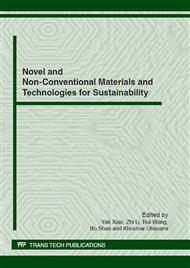p.469
p.477
p.487
p.495
p.500
p.506
p.513
p.522
p.528
Light Weight Earth Material and its Application in the Alteration of Log Dwellings
Abstract:
In the construction of log building, the building's insulation effect is mainly achieved by the timber tightly connected, which usually requires a large flat timber that lead to the consumption of high-quality wood.In recent years, by the decline in quality of forest resources, existing log buildings are constructed with fast-growing wood which small diameter, and larger curvature. Compared with the traditional log building, the log wall constructed with fast-growing wood has wider gap, poor insulation and poor pest control.So it greatly increased consumption of firewood for heating.To compensate for this defect, this paper make a study of log building constructions wall structured with light weight earth material. Mixture of plant fibre and cement, is used as main reinforce component, together with raw soil to enhance the ability of anti-cracking and heat preservation, fixing the mixture of ligth clay on inner side of the construcion's wall to enhance the ability of heat preservation and getting smooth wall surface by fill the gap in the wall, and easy for decorating interior wall.
Info:
Periodical:
Pages:
500-505
Citation:
Online since:
June 2012
Authors:
Price:
Сopyright:
© 2012 Trans Tech Publications Ltd. All Rights Reserved
Share:
Citation:


